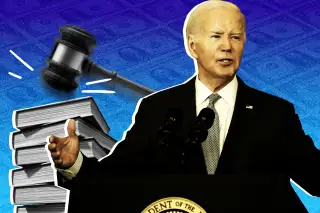Biden Student Loan Plan Blocked: What’s Left of Debt Relief After Court Orders?

Two federal court orders are putting a halt to key provisions of President Joe Biden’s marquee student loan repayment plan.
The Biden administration rolled out the Saving on a Value Education, or SAVE, repayment plan last summer after the U.S. Supreme Court struck down Biden’s first attempt at broad student loan forgiveness. About 8 million borrowers are enrolled, and more than half of them have had their monthly payments set to $0 while hundreds of thousands of other borrowers have had loans completely forgiven.
On Monday, two federal court judges presiding over separate legal challenges in Kansas and Missouri issued injunctions that block aspects of the plan while leaving much of the it in tact for current enrollees. The rulings apply nationwide, not just to borrowers in those two states.
“We strongly disagree with the Kansas and Missouri District Court rulings,” Education Secretary Miguel Cardona said in a statement Tuesday. “While we continue to review these rulings, the SAVE plan still means lower monthly payments for millions of borrowers.”
As opposed to a blanket forgiveness program, the SAVE plan overhauled the income-driven repayment system for federal student loans. It currently allows borrowers to make payments based on 10% of their disposable income. In some cases, borrowers with low original balances for undergraduate loans qualified for forgiveness of their remaining balance after making payments for 10 years.
Additionally, 4.6 million Americans have had their monthly loan bills set to $0 because, under SAVE’s more generous income rules, they were considered to have no disposable income.
Here’s how the federal court orders affect borrowers on SAVE.
Where SAVE stands after federal injunctions
In a lawsuit led by the state of Missouri, a federal judge blocked any new loan forgiveness through SAVE while the case plays out in court.
Under the SAVE plan, borrowers who made payments for at least 10 years and up to 25 years could have their remaining balances forgiven, depending on the original balance of the loans and whether the loans were for undergraduate or graduate studies. This new forgiveness timeline provided debt relief sooner than other income-driven repayment plans, which usually canceled remaining loans after 20 years of payments.
The state of Missouri and six other Republican-led states sued the Biden administration in part because they say the accelerated forgiveness timeline of SAVE causes “irreparable harm” to MOHELA, a quasi-government student loan servicer in Missouri that oversees a large portfolio of federal student loans.
Essentially, the state argues that forgiven loans hurt the revenues of MOHELA. A federal judge in Missouri — who was appointed by the Obama administration — agreed, granting a preliminary injunction that halts any new forgiveness under SAVE but keeps the other provisions in tact.
In neighboring Kansas, a separate federal judge also appointed by the Obama administration issued a preliminary injunction Monday that blocks different components of the SAVE program from going into effect.
This halts a slew of new benefits for SAVE enrollees that were slated to roll out in July. Chief among them: Monthly payments for borrowers with undergraduate loans were going to be slashed in half, going from 10% of one’s disposable income to 5%. Borrowers with a mix of graduate and undergraduate loans were in line for a payment reduction, too.
These new benefits are now on hold as the case is battled out in court.
Combined, it means that borrowers enrolled in SAVE will not qualify for the accelerated forgiveness timeline and will not have their monthly payments decreased next month.
However, borrowers can still stand to gain from the program’s other benefits, including monthly payments pegged to 10% of disposable income — which in many cases is $0 — as well as waived interest for any monthly payment amount that doesn’t at least cover the loan’s interest. The waiver keeps balances from growing while enrolled in the SAVE program as was the case for some other income-driven repayment plans.
Through SAVE, the Biden administration has already forgiven the loans of over 400,000 borrowers. The injunctions do not affect the folks who have already received this benefit.
What’s next for SAVE and student loan forgiveness?
Student debt advocates worry that two separate federal injunctions don’t bode well for SAVE.
Travis Hornsby, the founder of Student Loan Planner, tweeted that the injunctions could suggest that “SAVE will probably get repealed by Supreme Court.” Similarly, the Student Borrower Protection Center, an advocacy group, warned that the injunctions could cause chaos for borrowers currently enrolled and puts the plan’s future in jeopardy.
The White House says it plans to appeal the injunctions.
“The Department of Justice will be appealing both decisions to block key provisions of our SAVE Plan,” White House Press Secretary Karine Jean-Pierre tweeted Tuesday. “We will never stop fighting to lower monthly payments and help borrowers get out from under the burden of student debt.”
Meanwhile, the Biden administration is forging ahead with its second attempt at broad student debt forgiveness, which could cancel $150 billion. This entirely separate proposal from SAVE is undergoing an official rulemaking process and has not been finalized yet.
When the final rule is released, however, it’s expected to face similar legal challenges.
More from Money:
Medical Debt vs. Student Loan Debt: Which Would You Cancel?
Navient Is Quietly Forgiving Private Student Loans Amid Pressure From Lawmakers